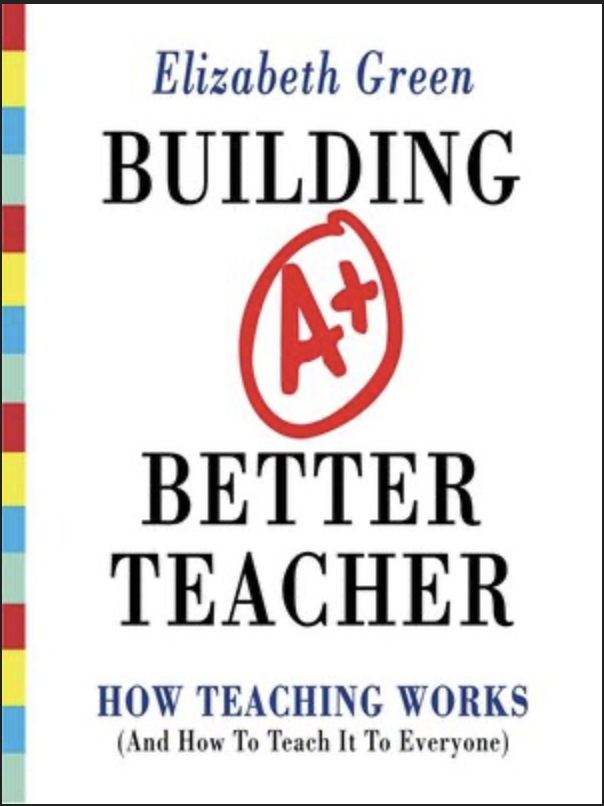Key Quote:
“Working alone, a teacher might excel or innovate, or might not; the outcome depended mostly on the individual. Working together increased every single person’s odds of improving” (p. 144). — Elizabeth Green
Key Points and Concepts
Education Philosophies
The autonomy/accountability framework suggests that teachers should be left alone and held accountable for their students’ results and outcomes.
Within this paradigm, there is a belief that rewarding top teachers and firing low-performing teachers will transform American education. Charter schools will hire and fire based on performance alone. In some cases, holding teachers accountable improved education, however “it was one thing to use the estimates to study the teacher population in the aggregate and quite another to use them to make decisions about individual teachers’ careers” (p. 307). It doesn’t take into account that the teachers could improve each year. This type of sorting makes sense if you adhere to the belief that good teachers are born, but as the books argues, teaching is “anything but natural work.”
Charter schools were generated under the idea that no-excuses, results-driven cultures make teachers accountable for results. When teachers were “free of bureaucratic red tape…and finally given the incentive to succeed, they produced outputs demanded of them” (p. 169). However, when teachers are mandated to do certain things, it can distract them from focusing on the actual meaning of the lesson.
No Child Left Behind is a perfect example of an initiative that fit under the accountability framework, and is an excellent example of why it doesn’t work. After No Child Left Behind:
• “American schools still operated more or less the same way they had for years, just with more tests” (p. 238).
• “The tests set relatively low bars for learning, emphasizing a wide but shallow set of skills instead of a steady progression of deeper understandings. Many teachers felt that the tests did not measure the higher-order skills children needed to reach success in college” (p. 245). This means teachers cannot dive into topics because they need to make sure they cover everything in case those topics come up for students on the tests.
The process / product paradigm for teaching and learning emphasizes the actual classroom practices that go into teaching and helping students learn and achieve better results.
Sorting based on process performance rather than outcome performance is more effective for improving education. “All schools needed to do was think more carefully about how they sorted teachers after they hired them – which ones they kept, which ones they rewarded, and which ones they let go – and they could generate dramatic change” (p. 293).
Achievement First is a program that adopts this paradigm, offering teachers “not only standards, but infrastructure; not only support, but coherent support [and a] formal coaching system pairing every teacher and principal with someone chosen specifically to help them improve”
(pp. 242-243).
What Great Teachers Do
Because great teachers are made, not born, the emphasis should not be on the traits of teachers, but rather their behaviors. Below are the skills and behaviors Green observed of great teachers:
Noticing a problem and diagnosing its source (this is fundamental to understanding what students are struggling with and how to help them move toward learning).
Challenging the reasoning, not the conclusion (this helps the teacher understand how the student got to the incorrect conclusion in order to help guide them to the correct reasoning, and ultimately the correct conclusion).
Deciding when to let detours happen and when to shut them down (sometimes it’s good to avoid tangents but sometimes clarifying students questions can be core to helping them work on certain tasks).
Listening to students’ questions, figuring out what they need to understand, then constructing a response to pull them there (this type of listening is key to moving a discussion forward).
Managing distractions by not causing further distractions (for example, calling a student out for bad behavior wastes time and often ends up embarrassing the student). Being subtle when getting students to focus and behave in class in a way that doesn’t derail the lesson is important.
“Relationship Capital” – Green describes a teacher who “established exceptionally strong relationships with students and their families through methodical habit.” Charles Sposato called every August and throughout the year, “making sure to vary the kinds of conversations so that he didn’t always bear bad news” (p. 285)
Additional Notes
Successful teaching is rare even in schools with many resources.
The American practice of tenure in education schools undermines reform efforts because it is based on the number of publications and not on the number of days in elementary schools.
• Green refers to a study about how infants look at the world through a web of generalizations, rules, and principles derived from observations rather than systems of rewards and punishments (pp. 274-275).
According to an APA report, “zero tolerance policies may create, enhance, or accelerate negative mental health outcomes for youth by creating increases in student alienation, anxiety, rejection, and breaking of healthy adult bonds” (p. 208).
“Teaching presented a million problems, but by working together, watching each other, and being watched,” they could craft solutions. (p. 167).
Rather than relying on school and student outcomes and scores to determine the effectiveness of education, the focus needs to be on what is actually happening in the classroom and developing the teachers themselves.
Green, E. (2014). Building a Better Teacher: How teaching works (and how to teach it to everyone). New York: W. W. Norton & Company, Inc.

“Working alone, a teacher might excel or innovate, or might not; the outcome depended mostly
on the individual. Working together increased every single person’s odds of improving” (p. 144).
Charter schools were generated under the idea that no-excuses, results-driven cultures make teachers accountable for results. When teachers were “free of bureaucratic red tape…and finally
given the incentive to succeed, they produced outputs demanded of them.”
“Relationship Capital” — Green describes a teacher who “established exceptionally strong relationships with students and their families through methodical habit.” Charles Sposato called every August and throughout the year, “making sure to vary the kinds of conversations so that he didn’t always bear bad news.”
